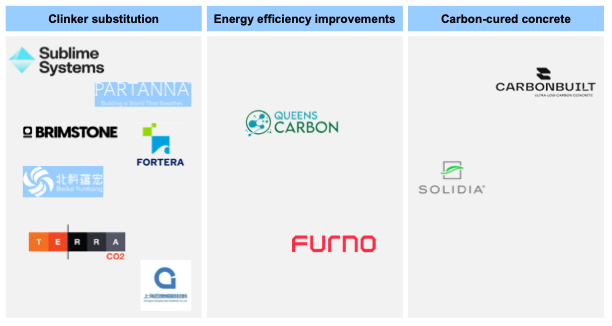
In a previous blog post, ADI discussed the highly carbon-intensive cement production process and highlighted that the clinker production process is where the majority of CO2 emissions occur. Clinker production emissions primarily result from the calcination process, followed by the use of fossil fuels to meet the energy demand for calcination. Consequently, these areas have been the focus of efforts to decarbonize the industry.
Aside from alternative fuels, there are three main approaches to decarbonizing the cement industry: (1) clinker substitution, (2) energy efficiency improvements, and (3) carbon-cured concrete. Various materials can substitute different proportions of clinker in cement mixes to produce low-carbon blends. For instance, Portland Limestone Cement (PLC) is widely used and can replace up to 10-15% of clinker with ground limestone, resulting in emission reductions of 5-10%. Ternary blends and calcined clay cements, such as LC3, allow for the substitution of 30-50% clinker in cement mixes by weight, leading to emissions reductions of approximately 30–50%. While specially engineered supplementary cementitious materials (SCMs) hold promise as a long-term solution, further research and development is needed. The use of pozzolans depends on their availability, as they are only found in certain regions. Exhibit 1 summarizes the CO2 emissions abatement potential of several clinker substitutes.

Exhibit 1. Abatement potential of different clinker substitutes. Source U.S. DOE, ADI
In recent years, several startups have been working to decarbonize the cement industry through clinker substitution, energy efficiency improvements, or carbon-cured cement, and are at various stages of commercialization. One notable startup is Fortera, which utilizes a recarbonation process. This process captures CO2 from kiln exhaust, mineralizes it into a cementitious material using a proprietary solvent, and then blends it with original Portland cement (OPC) as supplementary cementing materials (SCMs) or a cementitious binder. Fortera recently started a 15,000 tons per year (tpy) low-carbon cementitious material facility in Redding, California, at CalPortland’s facility. There are several other start-ups developing technologies to decarbonize the cement industry and are at various stages of commercialization. Exhibit 2 displays key startups in the space, segmented by their approach to decarbonizing the cement industry. We anticipate increased activity in this sector in the coming years, including the launch of new plants from these players and expansions.

Exhibit 2. Low-carbon and green cement start-ups.
ADI is closely following this space and various start-ups active in this area. We have recently published a multi-client study on the future of green and low-carbon cement which is available immediately to help stakeholders access this dynamic space. Download the study prospectus here >>
By Panuswee Dwivedi
ADI Analytics is a prestigious, boutique consulting firm specializing in oil & gas, energy transition, and chemicals since 2009. We bring deep, first-rate expertise in a broad range of markets including emission intensive industries, where we support Fortune 500, mid-sized and early-stage companies, and investors with consulting services, research reports, and data and analytics, with the goal of delivering actionable outcomes to help our clients achieve tangible results.
We also host the ADI Forum, one of Houston’s distinguished industry conferences, to bring c-suite executives from oil & gas, energy transition, and chemicals together for meaningful dialogue and strategic insights across the value chains.
Subscribe to our newsletter or contact us to learn more.



















